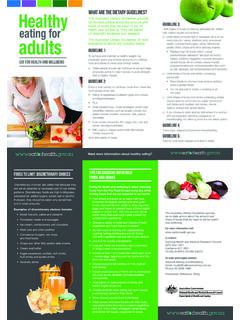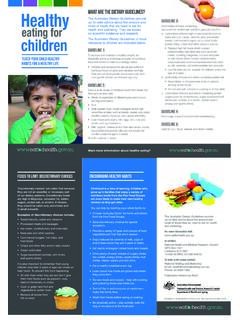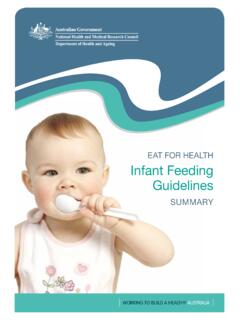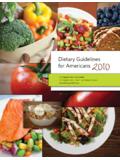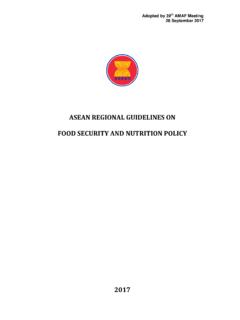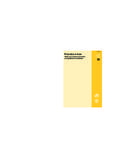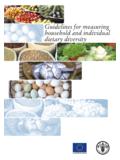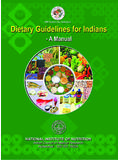Transcription of EAT FOR HEALTH Australian Dietary Guidelines
1 AustralianGuidelinesDietaryEAT FOR HEALTHEAT FOR HEALTHA ustralian Dietary GuidelinesProviding the scientific evidence for healthier Australian diets2013 Commonwealth of Australia 2013 Paper-based publicationThis work is copyright. You may reproduce the whole or part of this work in unaltered form for your own personal use or, if you are part of an organisation, for internal use within your organisation, but only if you or your organisation do not use the reproduction for any commercial purpose and retain this copyright notice and all disclaimer notices as part of that reproduction. Apart from rights to use as permitted by the Copyright Act 1968 or allowed by this copyright notice, all other rights are reserved and you are not allowed to reproduce the whole or any part of this work in any way (electronic or otherwise) without first being given the specific written permission from the Commonwealth to do so.
2 Requests and enquiries concerning reproduction and rights are to be sent to Strategic Communications, National HEALTH and Medical Research Council, GPO Box 1421, Canberra ACT 2600 or via email to Print: 1864965746 Commonwealth of Australia 2013 Electronic documentThis work is copyright. You may download, display, print and reproduce the whole or part of this work in unaltered form for your own personal use or, if you are part of an organisation, for internal use within your organisation, but only if you or your organisation do not use the reproduction for any commercial purpose and retain this copyright notice and all disclaimer notices as part of that reproduction. Apart from rights to use as permitted by the Copyright Act 1968 or allowed by this copyright notice, all other rights are reserved and you are not allowed to reproduce the whole or any part of this work in any way (electronic or otherwise) without first being given the specific written permission from the Commonwealth to do so.
3 Requests and enquiries concerning reproduction and rights are to be sent to Strategic Communications, National HEALTH and Medical Research Council, GPO Box 1421, Canberra ACT 2600 or via email to Online: 1864965754 Suggested citationNational HEALTH and Medical Research Council (2013) Australian Dietary Guidelines . Canberra: National HEALTH and Medical Research of NHMRC EndorsementThe Guidelines were considered by the Council on 30 November 2012 for recommendation to the CEO for issuing. The CEO was pleased to accept the Council s advice and agreed to issue to Guidelines under Section 7(1a) of the National HEALTH and Medical Research Council Act document is a general guide to appropriate practice, to be followed subject to the clinician s judgement and patient s preference in each individual case.
4 The guideline is designed to provide information to assist decision-making and is based on the best available evidence at the time of development of this publication. To obtain information regarding NHMRC publications contact:Email: Phone: Toll free 13 000 NHMRC (13 000 64672) or call (02) 6217 9000 Internet: NHMRC Publication reference: N55 Published: February 2013 PREFACEN ational HEALTH and Medical Research CounciliiiPrefaceNever in our nation s history have Australians had such a wide variety of Dietary options. Yet the rising incidence of obesity and type 2 diabetes in our population is evidence of the need for Australians to improve their HEALTH by making better Dietary are many ways for Australians to choose foods that promote their HEALTH and wellbeing while reducing their risk of chronic disease.
5 NHMRC s Australian Dietary Guidelines provide recommendations for healthy eating that are realistic, practical, and most importantly based on the best available scientific evidence. These Guidelines are an evolution of the 2003 edition of the Dietary Guidelines , integrating updates of the Dietary Guidelines for Older Australians (1999), the Dietary Guidelines for Adults (2003) and the Dietary Guidelines for Children and Adolescents in Australia (2003). They also include an update of the Australian Guide to Healthy Eating (1998). Providing the recommendations and the evidence that underpins them in a single volume, the Guidelines will help HEALTH professionals, policy makers and the Australian public cut through the background noise of ubiquitous Dietary advice that is often based on scant scientific evidence.
6 They form a bridge between research and evidence-based advice to address the major HEALTH challenge of improving Australians eating evidence for public HEALTH advice should be the best available. NHMRC is confident that the available evidence underpinning these Guidelines meets that criterion and is stronger than for any previous NHMRC Dietary guideline. Choice of food in Australia has become more complex as we have become a more diverse society, and many Australians take into account issues such as environmental concerns or cultural priorities in making their choices. We hope that these Guidelines act as a firm basis upon which these individual decisions may be made. For more than 75 years the Australian Government, primarily through NHMRC and Australian Government HEALTH departments, has provided nutrition advice to the public through food and nutrition policies, Dietary Guidelines and national food selection and all involved in developing these Guidelines are proud and privileged to have the responsibility to continue this important public Warwick Anderson AMChief Executive Officer National HEALTH and Medical Research CouncilFebruary 2013 Australian Dietary GuIDElINESN ational HEALTH and Medical Research CouncilvAustralian Dietary GuidelinesGuiDELiNE 1To achieve and maintain a healthy weight.
7 Be physically active and choose amounts of nutritious food and drinks to meet your energy needs. Children and adolescents should eat sufficient nutritious foods to grow and develop normally. They should be physically active every day and their growth should be checked regularly. Older people should eat nutritious foods and keep physically active to help maintain muscle strength and a healthy 2 Enjoy a wide variety of nutritious foods from these five groups every day: Plenty of vegetables, including different types and colours, and legumes/beans Fruit Grain (cereal) foods, mostly wholegrain and/or high cereal fibre varieties, such as breads, cereals, rice, pasta, noodles, polenta, couscous, oats, quinoa and barley lean meats and poultry, fish, eggs, tofu, nuts and seeds, and legumes/beans Milk, yoghurt, cheese and/or their alternatives, mostly reduced fat (reduced fat milks are not suitable for children under the age of 2 years)
8 And drink plenty of 3limit intake of foods containing saturated fat, added salt, added sugars and limit intake of foods high in saturated fat such as many biscuits, cakes, pastries, pies, processed meats, commercial burgers, pizza, fried foods, potato chips, crisps and other savoury snacks. Replace high fat foods which contain predominantly saturated fats such as butter, cream, cooking margarine, coconut and palm oil with foods which contain predominantly polyunsaturated and monounsaturated fats such as oils, spreads, nut butters/pastes and avocado. low fat diets are not suitable for children under the age of 2 years. b. limit intake of foods and drinks containing added salt.
9 Read labels to choose lower sodium options among similar foods. Do not add salt to foods in cooking or at the limit intake of foods and drinks containing added sugars such as confectionary, sugar-sweetened soft drinks and cordials, fruit drinks, vitamin waters, energy and sports If you choose to drink alcohol, limit intake. For women who are pregnant, planning a pregnancy or breastfeeding, not drinking alcohol is the safest 4 Encourage, support and promote 5 Care for your food; prepare and store it HEALTH and Medical Research CouncilviiContents Preface iiiAustralian Dietary Guidelines vintroduction 1 Why the Guidelines matter 1 Scope and target audience 2 Companion documents 3 How the Guidelines were developed 5 Five key evidence sources for the Guidelines 5 How the evidence was used 7 Challenges for adoption of the Guidelines 8 How to use the Guidelines 9 GuiDELiNE 1 Achieve and maintain a healthy weight Setting the
10 Scene Weight status and trends in Australia HEALTH effects associated with weight status Causes of overweight and obesity in the population Physical activity The evidence for achieve and maintain a healthy weight Primary and secondary prevention Dietary patterns and specific foods and drinks How Dietary patterns can affect energy balance and weight outcomes Practical considerations: achieve and maintain a healthy weight Physical activity and Dietary patterns in achieving and maintaining a healthy weight Weight loss in adults who are overweight Pregnant and breastfeeding women Infants, children and adolescents Older people Aboriginal and Torres Strait Islander peoples Australians of Asian origin People with eating disorders Practice guide for Guideline 1 29 EAT FOR HEALTH Australian Dietary guidELinEsnational HEALTH and Medical Research CouncilviiiGuiDELiNE 2 Enjoy a wide variety of nutritious foods Enjoy a wide variety of nutritious foods Setting the scene The evidence for consuming a wide variety of nutritious foods How consuming a wide variety of nutritious foods may improve HEALTH outcomes Practical considerations.
